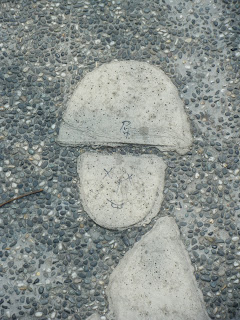(Note: I've gone out of chronological order here. Nana and I spent the middle of our Taiwan trip in Kaohsiung, Taiwan's second largest city. There are still some Taipei posts waiting in the wings.)
Nevertheless, several of the temples are still in use, making Lotus Pond a great place to see the colorful traditions of Chinese polytheism on display.
Our visit to Lotus Pond started at the Zuoying high-speed rail station, from which we walked about ten minutes to the north-east corner of the park.
The first big attraction on that side of the lake is a massive Confucian temple dedicated to one of the old Confucian saints.
It was there we stumbled onto a big foreign tour group, evidently visiting Kaohsiung on a cruise that was diverted from Japan after the Sendai quake. I wonder what they made of us: we crossed their paths a few times on our way around the lake.
Anyway, the architecture of the Confucian temple had some interesting quirks. For instance, the eaves were more colorful than what I can remember of the buildings we saw on the mainland. I wonder if this reflects older differences in taste, or more recent differences in restoration practices between Taiwan and the mainland.
Things only got more colorful as we made our way around.
Some of the temples we passed were astonishingly ornate. To my non-expert eye, some of them looked more Southeast Asian than purely Chinese.
One of the two big attractions is actually in the center of the lake, across from the halfway point of the western shore: a huge statue of a deified Chinese general.
The inside of the statue was actually a small temple. Pretty neat.
Further along the western shore is a shrine to Guanyin, the Goddess of Mercy in East Asian Buddhism. She stands over the water on top of a dragon.
You can actually walk through the dragon to view scenes that, I can only presume, depict some kind of Chinese teachings.
 |
| Watch out for the teeth. |
 |
| A wise man once said: "Grow your eyebrows really long and put a bat in your crotch." |
 |
| Um . . . |
 |
| Yes, that's the dragon's bum. |
Further along the shore, there's another pair of walk-through animals at the aptly-named Tiger and Dragon Pagodas.
Here, you go in the mouth of the dragon and out the mouth of the tiger.
 |
| Hey, pal--you've got something in your teeth. |
Our final stop on the western side of the lake was at a segment of the old Fengshan wall.
Again, I'm not really sure about reconstruction dates, but it's likely that this wall, dating to the mid 19th century, was the oldest thing we saw all day.
After the wall, we faced a difficult choice: catch a cab back to the train station, or hoof it back along the eastern side of the lake. As it turns out, we chose poorly--there isn't much to see on the eastern side besides a strange zip-line wakeboarding thingy and this humdrum temple.
Given the heat, the humidity, and the long walk . . . I think this guy just about sums up how we felt!
All in all, a good way to spend a day . . . though if I could do it again, I would have skipped the eastern side of the lake!
















No comments:
Post a Comment